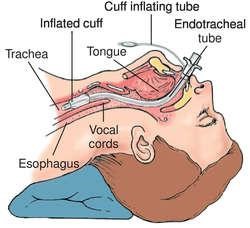A nurse is assessing a client who has COPD. Which of the following findings should the nurse expect?
Weight gain
Decrease in anteroposterior diameter of the chest
HCO3 24 mEq/L
pH 7.31
The Correct Answer is D
A. This is incorrect because weight gain is not expected in clients who have COPD, as they often have difficulty eating and digesting food due to dyspnea and fatigue.
B. This is incorrect because a decrease in anteroposterior diameter of the chest is not typical of COPD, as the condition causes hyperinflation and air trapping in the lungs, leading to an increase in chest size and a barrel-shaped appearance.
C. This is incorrect because HCO3 24 mEq/L is within the normal range for blood bicarbonate levels, which are 22 to 26 mEq/L. Clients who have COPD often have chronic respiratory acidosis, which stimulates the kidneys to retain bicarbonate and increase its levels in the blood to compensate for the low pH.
D. This is correct because pH 7.31 indicates acidosis, which is common in clients who have COPD due to impaired gas exchange and accumulation of carbon dioxide in the blood.
Nursing Test Bank
Naxlex Comprehensive Predictor Exams
Related Questions
Correct Answer is B
Explanation
Choice A reason
While thinning of secretions can be a positive sign, it's not always visible. A decrease in peak inspiratory pressure is a more objective indicator of improved airway patency.
Choice B reason.
Peak inspiratory pressure is the maximum pressure required to push air into the lungs. If suctioning is effective, it will remove secretions and reduce airway resistance, leading to a decrease in peak inspiratory pressure.
Choice C reason:
While a productive cough can indicate that secretions are being moved, it doesn't directly measure the effectiveness of suctioning.
Choice D reason:
Flattening of the artificial airway cuff: Flattening of the artificial airway cuff is not a relevant indicator of the effectiveness of suctioning. The cuff of an endotracheal tube is inflated to prevent air leaks around the tube and to maintain proper ventilation. It is not directly related to the effectiveness of suctioning.

Correct Answer is B, A, D, C
Explanation
B. Inspection is the first step in an abdominal assessment because it allows the nurse to observe the shape, size, symmetry, contour, and movement of the abdomen. Inspection also helps to identify any abnormalities such as scars, lesions, masses, or distension.
A. Auscultation is the second step in an abdominal assessment because it allows the nurse to listen to the bowel sounds and vascular sounds of the abdomen. Auscultation should be performed before palpation or apercussion because these maneuvers could alter the sounds.
D. Percussion is the third step in an abdominal assessment because it allows the nurse to elicit sounds from different organs and structures in the abdomen. Percussion helps to determine the size, location, density, and consistency of the organs and to detect any fluid or air accumulation.
C. Palpation is the last step in an abdominal assessment because it allows the nurse to feel the texture, temperature, tenderness, and masses of the abdomen. Palpation should be performed gently and carefully to avoid causing pain or injury to the client.
Whether you are a student looking to ace your exams or a practicing nurse seeking to enhance your expertise , our nursing education contents will empower you with the confidence and competence to make a difference in the lives of patients and become a respected leader in the healthcare field.
Visit Naxlex, invest in your future and unlock endless possibilities with our unparalleled nursing education contents today
Report Wrong Answer on the Current Question
Do you disagree with the answer? If yes, what is your expected answer? Explain.
Kindly be descriptive with the issue you are facing.
